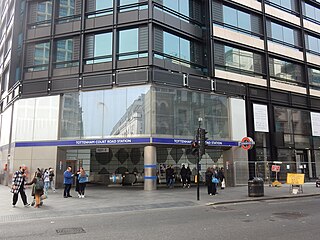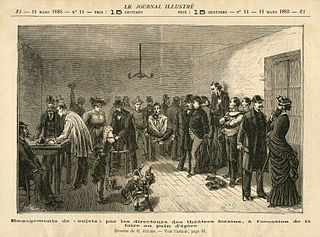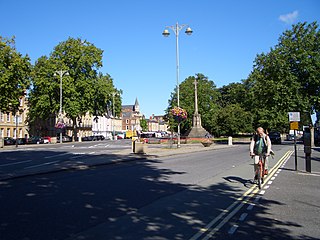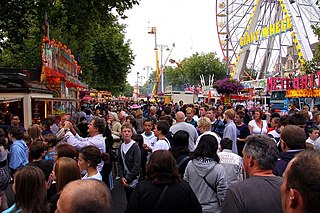Related Research Articles

Stow-on-the-Wold is a market town and civil parish in Gloucestershire, England, on top of an 800-foot hill at the junction of main roads through the Cotswolds, including the Fosse Way (A429), which is of Roman origin. The town was founded by Norman lords to absorb trade from the roads converging there. Fairs have been held by royal charter since 1330; a horse fair is still held on the edge of town nearest to Oddington in May and October each year.

Tottenham Court Road is a London Underground and Elizabeth line station in St Giles in the West End of London. The station is served by the Central line, the Elizabeth line and the Charing Cross branch of the Northern line. The station is located at St Giles Circus, the junction of Tottenham Court Road, Oxford Street, New Oxford Street and Charing Cross Road and is in Travelcard Zone 1, with a second entrance at Dean Street.

The cakewalk was a dance developed from the "prize walks" held in the mid-19th century, generally at get-togethers on Black slave plantations before and after emancipation in the Southern United States. Alternative names for the original form of the dance were "chalkline-walk", and the "walk-around". It was originally a processional partner dance performed with comical formality, and may have developed as a subtle mockery of the mannered dances of white slaveholders.

Tavistock is an ancient stannary and market town within West Devon, England. It is situated on the River Tavy from which its name derives. At the 2011 census the three electoral wards had a population of 13,028. It traces its recorded history back to at least 961 when Tavistock Abbey, whose ruins lie in the centre of the town, was founded. Its most famous son is Sir Francis Drake.

Fried dough is a North American food associated with outdoor food stands in carnivals, amusement parks, fairs, rodeos, and seaside resorts. "Fried dough" is the specific name for a particular variety of fried bread made of a yeast dough; see the accompanying images for an example of use on carnival-booth signs. Fried dough is also known as fry dough, fry bread (bannock), fried bread, doughboys, elephant ears, beaver tails, scones, pizza fritte, frying saucers, and buñuelos. These foods are virtually identical to each other and some yeast dough versions of beignets, and recognizably different from other fried dough foods such as doughnuts or fritters.

Gingerbread refers to a broad category of baked goods, typically flavored with ginger, cloves, nutmeg, and cinnamon and sweetened with honey, sugar, or molasses. Gingerbread foods vary, ranging from a moist loaf cake to forms nearly as crisp as a ginger snap.

Clun is a town in south west Shropshire, England, and the Shropshire Hills Area of Outstanding Natural Beauty. The 2011 census recorded 680 people living in the town. Research by the Campaign for the Protection of Rural England suggests that Clun is one of the most tranquil locations in England.

Candy apples are whole apples covered in a sugar candy coating, with a stick inserted as a handle. These are a common treat at fall festivals in Western culture in the Northern Hemisphere, such as Halloween and Guy Fawkes Night because these festivals occur in the wake of annual apple harvests. Although candy apples and caramel apples may seem similar, they are made using distinctly different processes.

Showman can have a variety of meanings, usually by context and depending on the country.

A funhouse or fun house is an amusement facility found in amusement parks and funfair midways, equipped with various devices designed to surprise, challenge, and amuse visitors. Unlike thrill rides or dark rides, fun houses are participatory attractions, where visitors enter and move around at their own preference. Incorporating aspects of a playful obstacle course, they seek to distort conventional perceptions and startle people with unpredictable physical circumstances in an ambiance of wacky whimsicality.

St Giles' is a wide boulevard leading north from the centre of Oxford, England. At its northern end, the road divides into Woodstock Road to the left and Banbury Road to the right, both major roads through North Oxford. At the southern end, the road continues as Magdalen Street at the junction with Beaumont Street to the west. Also to the west halfway along the street is Pusey Street. Like the rest of North Oxford, much of St Giles' is owned by St John's College.

St Giles' Fair is an annual fair held in St Giles', a wide thoroughfare in central north Oxford, England. The origins of the fair can be traced back to medieval times where it became one of England's dynamic trading centers. The fair has survived medieval times and is organised for a two-day duration in September each year by the Oxford City Council with the London and Home Counties section of the Showmen's Guild of Great Britain.

Magdalen Street is a short shopping street in central Oxford, England, just north of the original north gate in the city walls. Traditionally, the name of the street is pronounced and not as the name of the Magdalen College, which is always.

A street fair celebrates the character of a neighborhood. As its name suggests, it is typically held on the main street of a neighborhood.

St. Giles' Church is a church in North Oxford, England. It is at the northern end of the wide thoroughfare of St Giles', at the point where it meets Woodstock Road and Banbury Road. It stands between where Little Clarendon Street joins Woodstock Road and Keble Road joins Banbury Road.

A traveling carnival, usually simply called a carnival, travelling funfair or travelling show, is an amusement show that may be made up of amusement rides, food vendors, merchandise vendors, games of chance and skill, thrill acts, and animal acts. A traveling carnival is not set up at a permanent location, like an amusement park or funfair, but is moved from place to place. Its roots are similar to the 19th century circus with both being fitted-up in open fields near or in town and moving to a new location after a period of time. In fact, many carnivals have circuses while others have a clown aesthetic in their decor. Unlike traditional carnival celebrations, the North American traveling carnival is not tied to a religious observance.

The Whip was a ride originally designed and built by W.F. Mangels Company of Coney Island, New York, United States. William F. Mangels patented the ride in 1914 and it soon became extremely popular.
Giles Lewin is a British violinist and bagpiper. Currently a member of The Carnival Band, he was also a founding member of the folk band, Bellowhead.

Witching Waves is an historical flat ride that was installed at several amusement parks worldwide. The first was at Luna Park on Coney Island, New York, United States, in 1907, where it was one of the most popular rides.

St Giles' Church, Camberwell, is the parish church of Camberwell, a district of London which forms part of the London Borough of Southwark. It is part of Camberwell Deanery within the Anglican Diocese of Southwark in the Church of England. The church is dedicated to Saint Giles, the patron saint of the disabled. A local legend associates the dedication of St Giles with a well near Camberwell Grove, which may also have given Camber-well its name. An article on the church from 1827 states: "it has been conjectured that the well might have been famous for some medicinal virtues and might have occasioned the dedication of the church to this patron saint of cripples."
References
- ↑ Carnival Booth Idea: Cake Walk, Carnival Savers.
- ↑ Alison Petch, Calendar related artefacts: St Giles Fair, England: The Other Within, Pitt Rivers Museum, Oxford, UK.